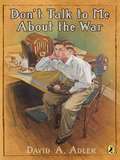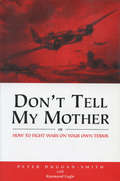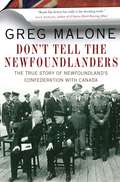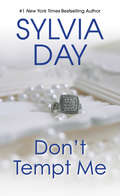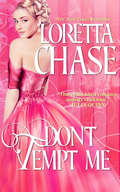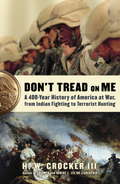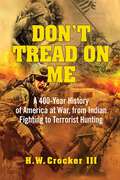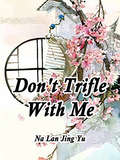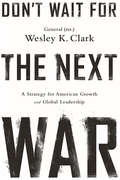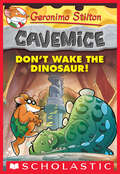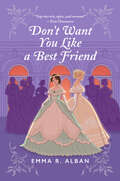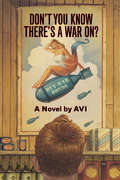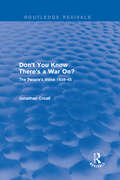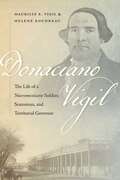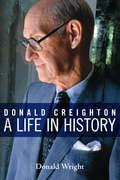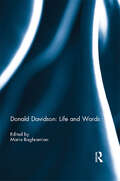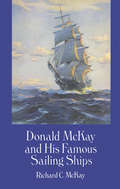- Table View
- List View
Don't Stop Believin'
by Robert K. Johnston Craig Detweiler Barry TaylorElvis Presley. Andy Warhol. Nike. Stephen King. Ellen DeGeneres. Sim City. Facebook. These American pop culture icons are just a few examples of entries you will find in this fascinating guide to religion and popular culture. Arranged chronologically from 1950 to the present, this accessible work explores the theological themes in 101 well-established figures and trends from film, television, video games, music, sports, art, fashion, and literature. This book is ideal for anyone who has an interest in popular culture and its impact on our spiritual lives. Contributors include such experts in the field as David Dark, Mark I. Pinsky, Lisa Swain, Steve Turner, Lauren Winner, and more.
Don't Talk to Me About the War
by David A. AdlerThirteen-year-old Tommy Duncan just wants to root for the Brooklyn Dodgers and listen to his favorite radio programs. But it?s 1940, and the world is about to change. All his friend Beth wants to discuss is the war in Europe. Don?t talk to Tommy about that, though. He has more immediate concerns? like Beth starting to wear earrings and his mother?s declining health. The stories of a Jewish friend at school, however, begin to make the war more real to him, and Tommy, like the world around him, is sure to be forever changed. .
Don't Tell My Mother: How to Fight War on Your Own Terms
by Peter Duggan-Smith Raymond EaglePeter Duggan-Smith was born in 1916 to an actress mother. As she was always on the move he was brought up by two maiden aunts until he was accepted to train for a sea-going career on the cadet ship H.M.S. Conway. It was on the last of several voyages to New Zealand as a Merchant Navy apprentice that his life of adventure began — though it did not always turn out as he had planned! The one constant in Peter’s life was his love of flying; by the end of his final flight in Cambodia in 1974, he had racked up more than 17,000 flying hours–in no less than 70 types of piston-engine aircraft. Peter was small in stature, but a giant among adventurers, with a rare ability to take the reader along with him through his many escapades. Raymond Eagle, FSA Scot., is a historian with a particular interest in Scottish and military history. His early years were spent in Eastleigh, Hampshire where, at the age of ten, he had a grandstand view of the Battle of Britain. This gave him a life-long interest in aviation and a great respect for his boyhood heroes, the aircrews of the RAF and Dominion air forces. In 1949 he joined the British army as a national serviceman and was commissioned in the Royal Artillery, spending two years in Hong Kong before continuing in the Territorial Army (Militia). Arriving in Canada in March 1967 with his wife and two young sons, he worked for twenty years in executive positions with various medical charities, writing purely as a hobby. Articles published included such areas as history, environment, health and travel. In November 1991, Eagle’s first book was published in Scotland by Lochar Publishing of Moffat, Seton Gordon — The Life and Times of a Highland Gentleman, a biography of the well-known Scottish naturalist, historian and photographer, who wrote 27 books on the Highlands and Hebrides.
Don't Tell the Nazis
by Marsha Forchuk SkrypuchThe year is 1941. Krystia lives in a small Ukrainian village under the cruel -- sometimes violent -- occupation of the Soviets. So when the Nazis march into town to liberate them, many of Krystia's neighbors welcome the troops with celebrations, hoping for a better life.But conditions don't improve as expected. Krystia's friend Dolik and the other Jewish people in town warn that their new occupiers may only bring darker days.The worst begins to happen when the Nazis blame the Jews for murders they didn't commit. As the Nazis force Jews into a ghetto, Krystia does what she can to help Dolik and his family. But what they really need is a place to hide. Faced with unimaginable tyranny and cruelty, will Krystia risk everything to protect her friends and neighbors?
Don't Tell the Newfoundlanders: The True Story of Newfoundland's Confederation with Canada
by Greg MaloneThe true story, drawn from official documents and hours of personal interviews, of how Newfoundland and Labrador joined Confederation and became Canada's tenth province in 1949. A rich cast of characters--hailing from Britain, America, Canada and Newfoundland--battle it out for the prize of the resource-rich, financially solvent, militarily strategic island. The twists and turns are as dramatic as any spy novel and extremely surprising, since the "official" version of Newfoundland history has held for over fifty years almost without question. Don't Tell the Newfoundlanders will change all that.
Don't Tempt Me
by Loretta ChaseSpunky English girl overcomes impossible odds and outsmarts heathen villains. That's the headline when Zoe Lexham returns to England. After twelve years in the exotic east, she's shockingly adept in the sensual arts. She knows everything a young lady shouldn't and nothing she ought to know. She's a walking scandal, with no hope of a future . . . unless someone can civilize her. Lucien de Grey, the Duke of Marchmont, is no knight in shining armor. He's cynical, easily bored, and dangerous to women. He charms, seduces, and leaves them--with parting gifts of expensive jewelry to dry their tears. But good looks, combined with money and rank, makes him welcome everywhere. The most popular bachelor in the Beau Monde can easily save Zoe's risquÉ reputation . . . if the wayward beauty doesn't lead him into temptation, and a passion that could ruin them both.
Don't Tempt Me
by Loretta ChaseSpunky English girl overcomes impossible odds and outsmarts heathen villains.That's the headline when Zoe Lexham returns to England. After twelve years in the exotic east, she's shockingly adept in the sensual arts. She knows everything a young lady shouldn't and nothing she ought to know. She's a walking scandal, with no hope of a future . . . unless someone can civilize her.Lucien de Grey, the Duke of Marchmont, is no knight in shining armor. He's cynical, easily bored, and dangerous to women. He charms, seduces, and leaves them--with parting gifts of expensive jewelry to dry their tears. But good looks, combined with money and rank, makes him welcome everywhere. The most popular bachelor in the Beau Monde can easily save Zoe's risqué reputation . . . if the wayward beauty doesn't lead him into temptation, and a passion that could ruin them both.
Don't Tempt Me (Georgian #4)
by Sylvia DayIn this Georgian-era romance by the #1 bestselling author of the Crossfire Series, an Irish soldier-for-hire falls for an enigmatic French femme fatale.SOMETIMES TEMPTATION . . . A hardened mercenary as adept in bed as in battle, Simon Quinn can have any woman he wants, but he prefers those who know the rules of the game. That way it&’s easier to leave them behind...CAN&’T BE AVOIDED But Lysette Rousseau is one female he can&’t figure out. Beautiful, sensual, seductive, she should be the perfect match for Simon, yet something about her ties him in knots. Bold and manipulative one time, sweetly innocent the next, she is an enigma bound to bring trouble . . . impossible to resist.Praise for Don&’t Tempt Me &“Day crafts several intricate love stories (for a mother and twin daughters) that seamlessly slip from one scorching romance to another. Readers will devour every word of this daringly original, boldly sensual and brilliantly plotted book—and they&’ll be breathless by its riveting conclusion.&” —RT Book Reviews, Top Pick &“Features a cast of colorful characters and a complex and intriguing plot. It will appeal most to readers who like their romantic adventures fast paced.&” —Library Journal &“Dangerous liaisons and deceptions are the key ingredients in the latest addition to Day&’s sexy, espionage-steeped Georgian historical-romance series.&” —Booklist
Don't Tempt Me (The\fallen Women Ser. #1)
by Loretta ChaseScandal! Gossip!When kidnapped English heiress Zoe Lexham daringly escapes from captivity, her problems have only begun. After 12 years in a harem, she knows far more about erotic practices than how to conduct a proper conversation in civilized parlors.Her reception from London society's ladies is arctic; the proposals from their husbands and brothers exceedingly...warm; and her loving, but overwhelmed, aristocratic family fear she'll be an outcast forever—unless someone can launch her to success (and a good marriage)!Enter Lucien de Grey, the Duke of Marchmont...Lucien is no knight in shining armor. He's cynical, easily bored, dangerous to women, and utterly indifferent to popular opinion. But good looks, combined with money and title, make him welcome everywhere. The most popular bachelor in the Beau Monde can easily save Zoe's risqué reputation…if he can prevent the chemistry between them from getting so out of hand...so often...and so deliciously!
Don't Touch That Dial!: Radio Programming in American Life, 1920 - 1960
by J. MacDonaldFor those who loved it, as well as for those who missed it, this book brings to life old-time radio, which was often called a "theater of the mind." It is an entertaining and important history of radio programming and its role in shaping social values and thought in America.
Don't Tread on Me: A 400-Year History of America at War, from Indian Fighting to Terrorist Hunting
by H. W. Crocker III* Should Patton have been promoted over Eisenhower? * Did the U. S. military win- and Congress lose- the Vietnam War? * Was it right to depose Saddam Hussein- and is it wrong to worry about a possible Iraqi civil war? The answer to these questions is a resounding yes, says author H.W. Crocker III in this stirring and contrarian new book. In Don't Tread on Me, Crocker unfolds four hundred years of American military history, revealing how Americans were born Indian fighters whose military prowess carved out first a continental and then a global empire- a Pax Americana that has been a benefit to the world. From the seventeenth century on, he argues, Americans have shown a jealous regard for their freedom- and have backed it up with an unheralded skill in small-unit combat operations, a tradition that includes Rogers' Rangers, Merrill's Marauders, and today's Special Forces. He shows that Americans were born to the foam too, with a mastery of naval gunnery and tactics that allowed America's Navy, even in its infancy, to defeat French and British warships and expand American commerce on the seas. Most of all, Crocker highlights the courage of the dogface infantry, the fighting leathernecks, and the daring sailors and airmen who have turned the tide of battle again and again. In Don't Tread on Me, still forests are suddenly pierced by the Rebel Yell and a surge of grey. Teddy Roosevelt's spectacles flash in the sunlight as he leads his Rough Riders charging up San Juan Hill. American doughboys rip into close-quarters combat against the Germans. Marines drive the Japanese out of their island fortresses using flamethrowers, grenades, and guts. GIs slug their way into Hitler's Germany. The long twilight struggle against communism is fought in the snows of Korea and the steaming jungles of Vietnam. And today, U. S. Navy SEALs and U.S. Army Rangers battle Islamist terrorists in the bleak mountains of Afghanistan, just as their forebears fought Barbary pirates two hundred years ago. Fast-paced and riveting, Don't Tread on Me is a bold look at the history of America at war.
Don't Tread on Me: A 400-Year History of America at War, from Indian Fighting to Terrorist Hunting
by H. W. Crocker IIIThe Fighting Men Who Made America GreatIn this stirring and contrarian modern classic, bestselling author H. W. Crocker III unfolds four hundred years of American military history, revealing how Americans were born Indian fighters whose military prowess carved out first a continental and then a global empire—a Pax Americana that made the modern world. From the seventeenth century on, he argues, Americans have shown a jealous regard for their freedom—and have backed it up with an unheralded skill in small-unit combat operations, a tradition that includes Rogers&’s Rangers, Merrill&’s Marauders, and today&’s Special Forces. He shows that Americans were born to the foam, too, with a mastery of naval gunnery and tactics that allowed their navy, even in its infancy, to defeat French and British warships and expand U.S. commerce on the seas. Most of all, Crocker highlights the courage of the dogface infantry, the fighting leathernecks, and the daring sailors and airmen who have turned the tide of battle again and again. In Don&’t Tread on Me, still forests are suddenly pierced by the Rebel Yell and a surge of grey. Teddy Roosevelt&’s spectacles flash in the sunlight as he leads his Rough Riders&’ charge up San Juan Hill. Yankee doughboys rip into close-quarters combat against the Germans. Marines drive the Japanese out of their island fortresses with flamethrowers, grenades, and guts. GIs slug their way into Hitler&’s Germany. The long twilight struggle against communism is fought in the snows of Korea and the steaming jungles of Vietnam. Navy SEALs and Army Rangers battle Islamist terrorists in the bleak mountains of Afghanistan, just as their forefathers fought Barbary pirates two hundred years ago. And we are reminded of the wisdom of America&’s greatest generals: George Washington, Andrew Jackson, Robert E. Lee, Ulysses Grant, John Pershing, George Patton, Douglas MacArthur, and Norman Schwarzkopf. Fast-paced and riveting—and completely updated from its original 2006 publication—Don&’t Tread on Me is a bold look at the history of America at war.
Don't Trifle With Me: Volume 1 (Volume 1 #1)
by Na LanJingYuYan Hongye had grown up in an orphanage. Because her collarbone had a small birthmark that resembled a red maple leaf, the old dean had given her this name.
Don't Trifle With Me: Volume 2 (Volume 2 #2)
by Na LanJingYuYan Hongye had grown up in an orphanage. Because her collarbone had a small birthmark that resembled a red maple leaf, the old dean had given her this name.
Don't Wait for the Next War: A Strategy for American Growth and Global Leadership
by Wesley K. ClarkWith the end of the Cold War came not the end of history, but the end of America’s sense of its strategic purpose in the world. Then, after a decade of drift, the US was violently dragged back into international conflict. Its armed forces responded magnificently but its leaders’ objectives were substantially flawed. We fought the wrong war-twice-for reasons that were opaque, and few American citizens understood the cause for which their sons and daughters were fighting and dying. War is a poor substitute for strategic vision, and decisions made in the heat of imminent conflict are often limited by the emotions of the moment. In Don’t Wait for the Next War, Wesley K. Clark, a retired four-star general of the US army and former Democratic candidate for president, presents a compelling argument for continued American global leadership and the basis on which it can succeed-a new American strategy. America needs both new power and deeper perspective. The platform for American leadership is to use America’s energy resources to spark sustainable economic growth, building new strength to deal with pressing domestic issues like the deficit as well as the longer term challenges to US security-terrorism, cyber threats, the next financial crisis, China’s rising power, and climate change. Such a strategy is not only achievable but essential, and it is urgently needed. This is the true test of American leadership for the next two decades, but it must start now, so America has the power and vision to deal with the acute crises that will inevitably come-in the Mideast, Europe, or Asia.
Don't Wake the Dinosaur! (Geronimo Stilton Cavemice #6)
by Geronimo StiltonGeronimo Stilton's ancient ancestor Geronimo Stiltonoot is back in another prehistoric adventure!It's the night of the big Cavemouse Idol competition, but Geronimo Stiltonoot isn't there. He has a cold, and goes to bed early. But when it's discovered that the contest's valuable grand prize has been stolen, Geronimo is the main suspect! He must prove his innocence . . . or he'll end up in enormouse trouble!
Don't Want You Like a Best Friend: A Novel (The Mischief & Matchmaking Series #1)
by Emma R. AlbanA swoon-worthy debut queer Victorian romance in which two debutantes distract themselves from having to seek husbands by setting up their widowed parents, and instead find their perfect match in each other—the lesbian Bridgerton/Parent Trap you never knew you needed!Gwen has a brilliant beyond brilliant idea.It’s 1857, and anxious debutante Beth has just one season to snag a wealthy husband, or she and her mother will be out on the street. But playing the blushing ingenue makes Beth’s skin crawl and she’d rather be anywhere but here. Gwen, on the other hand, is on her fourth season and counting, with absolutely no intention of finding a husband, possibly ever. She figures she has plenty of security as the only daughter of a rakish earl, from whom she’s gotten all her flair, fun, and less-than-proper party games.“Let’s get them together,” she says.It doesn’t take long for Gwen to hatch her latest scheme: rather than surrender Beth to courtship, they should set up Gwen’s father and Beth’s newly widowed mother. Let them get married instead.“It’ll be easy” she says.There’s just…one, teeny, tiny problem. Their parents kind of seem to hate each other.But no worries. Beth and Gwen are more than up to the challenge of a little twenty-year-old heartbreak. How hard can parent-trapping widowed ex-lovers be?Of course, just as their plan begins to unfold, a handsome, wealthy viscount starts calling on Beth, offering up the perfect, secure marriage. Beth’s not mature enough for this…Now Gwen must face the prospect of sharing Beth with someone else, forever. And Beth must reckon with the fact that she’s caught feelings, hard, and they’re definitely not for her potential fiancé. That’s the trouble with matchmaking: sometimes you accidentally fall in love with your best friend in the process.
Don't You Know There's a War On?
by AviWorld War II is on everyone's mind and in every headline, and Howie Crispers has a hunch that his school principal is a spy. With a little snooping around, Howie finds out something even more alarming. Principal Lomister may not be a spy, but he is plotting to get rid of Howie's favorite teacher. Howie's dad is fighting Nazis overseas, and his mom is working hard to support the war effort, so Miss Gossim is the only person Howie can depend on. With the help of his friends, and a plan worthy of radio show superhero Captain Midnight, Howie intends to save Miss Gossim!
Don't You Know There's a War On?: The People's Voice 1939-45 (Routledge Revivals)
by Jonathan CroallWas the country really united in the face of the common enemy? Did people actually put the community’s needs before their own? Or were such ideas simply a series of myths created at the time and nurtured ever since. The recollections of this book, first published in 1989, attempt to answer such questions by evoking the reality of life on the home front during the war years. Here is a uniquely personal portrait of a nation at war, extensively illustrated with photographs, diaries, letters, poems, and other memorabilia belonging to the men and women whose wartime lives fill this absorbing book. This title will be of interest to students of history.
Donaciano Vigil: The Life of a Nuevomexicano Soldier, Statesman, and Territorial Governor
by Helene Boudreau Maurilio E. VigilBorn in Santa Fe in 1802, Donaciano Vigil was an active participant in many of the critical events in New Mexico&’s history in the nineteenth century. Vigil was witness to New Mexico&’s transition from a Spanish province (1802–1821) to a Mexican department (1821–1846) and eventually to an American territory (1846–1877), and he was a key player in most of the events of that era. As a Hispano soldier and officer in the New Mexico Militia, he was instrumental in the Navajo Wars, the Rio Arriba insurrection of 1837, the Texas invasion of 1841, and the American invasion of 1846. As a Mexican statesman in New Mexico, he was one of the most active assemblymen. Following the American occupation, he joined the civil government, first as secretary, then as governor. It was in these roles that Donaciano left an enduring impact and legacy on the territory.In this gripping biography of a remarkable man, Maurilio E. Vigil and Helene Boudreau fill the gap within the scholarship on Hispanics in nineteenth-century New Mexico.
Donald Creighton
by Donald WrightA member of the same intellectual generation as Harold Innis, Northrop Frye, and George Grant, Donald Creighton (1902-1979) was English Canada's first great historian. The author of eleven books, including The Commercial Empire of the St. Lawrence and a two-volume biography of John A. Macdonald, Creighton wrote history as if it "had happened," he said, "the day before yesterday." And as a public intellectual, he advised the prime minister of Canada, the premier of Ontario, and - at least on one occasion - the British government.Yet he was, as Donald Wright shows, also profoundly out of step with his times. As the nation was re-imagined along bilingual and later multicultural lines in the 1960s and 1970s, Creighton defended a British definition of Canada at the same time as he began to fear that he would be remembered only "as a pessimist, a bigot, and a violent Tory partisan."Through his virtuoso research into Creighton's own voluminous papers, Wright paints a sensitive portrait of a brilliant but difficult man. Ultimately, Donald Creighton captures the twentieth-century transformation of English Canada through the life and times of one of its leading intellectuals.
Donald Davidson: Life and Words
by Maria BaghramianDonald Davidson (1917-2003) was one of the most prominent philosophers of the second half of the twentieth century. His thinking about language, mind, and epistemology has shaped the views of several generations of philosophers. This book brings together articles by a host of prominent philosophers to provide new interpretations of Davidson’s key ideas about meaning, language and thought. The book opens with short commemorative pieces by a wide range of people who knew Davidson well, giving us glimpses into the life of a great philosopher, a beloved husband and father, a colleague, teacher and friend. The chapter by Lepore and Ludwig and the ensuing heated debate with Frederick Stoutland on how to interpret Davidson demonstrate why Davidson’s legacy has become a disputed intellectual territory. The chapters by Kathrin Glüer, Peter Pagin, Barry Smith, James Higginbotham and William Child, all eminent philosophers of language, are prime examples of just one strand of this legacy, while the piece by Sophie Gibb gives us an opening to Davidson’s enormous contribution to philosophy of mind. Donald Davidson: Life and Words closes with a piece by Davidson himself, first published in 1995 in the International Journal of Philosophical Studies, where he brings together the various strands of his work in a Unified Theory of speech and action. This book comprises key articles first published in the International Journal of Philosophical Studies and previously unpublished commemorative pieces, and serves as a fitting dedication to the work and memory of a great philosopher.
Donald Dean VC: The Memoirs of a Volunteer & Territorial from Two World Wars
by Terry Crowdy Susan BavinDonald Dean lied about his age to enlist in the Queen's Own Royal West Kent Regiment and serve on the Western Front, where he worked his way up from Private to acting Captain. It was in the last weeks of the war, late in September 1918, that he won his VC for leading a platoon in the determined defense of a recently captured and isolated trench against repeated German counterattacks. In one of these attacks, the Germans actually broke into the trench, forcing Dean to break off a radio call for artillery support with the words 'The Germans are here, goodbye!' Refusing to be overrun, he personally killed four of the Germans before they were finally evicted. Dean also served in World War II, witnessing the fall of France in 1940 and claiming to be the last Brit to get out of Boulogne. His frank account of the evacuation challenges some cherished conceptions and is very critical of the conduct of the Irish Guards in particular. He went on to fight in Madagascar, Sicilya and the Italian mainland. Donald Dean died in 1985.Military historian Terry Crowdy has edited Dean's letters and diaries, never previously published, adding additional notes and material from official reports to give the reader context. The result is a moving, often amusing and inspiring portrait of a little-known hero of two world wars.
Donald McKay and His Famous Sailing Ships (Dover Maritime Series)
by Richard C. McKay"A magical tale of a master-mechanic and creative artist, whose genius lifted the construction of sailing ships from the level of a journeyman's trade to the plane of an exact science. He stands pre-eminent among those acute and daring Americans whose marine achievements were the wonder of the world … and enthroned the United States of America as Mistress of the Seas!" — Foreword.Donald McKay was the presiding genius of the nineteenth-century designer-builders who brought the American clipper ship and other sailing vessels to the acme of perfection. Year after year, his shipyard in East Boston launched a flotilla of the largest, fastest, and most beautiful clippers afloat. Such vessels as the famed Flying Cloud, Sovereign of the Seas, Flying Fish, Westward Ho, Great Republic, and many more surpassed in size, beauty, strength, and speed all that had gone before. McKay's ships proclaimed a new era of American supremacy on the high seas and helped put her first among the trading nations of the world.This rare and valuable study, written by McKay's descendant who had access to important family records, reveals McKay's extraordinary accomplishments as it re-creates the great era of the American sailing packet and clipper ship. In the end, steamships replaced McKay's masterworks, but never eclipsed the magnificent sailing tradition whose climax they represented.Enhanced with 58 superb illustrations, including numerous views of McKay's ships — in port, on the high seas, and in close-up detail — along with a wealth of plans, models, maps, and other materials, this volume will find an eager audience among ship enthusiasts and modelers, marine historians, and lovers of Americana.
Donald Rodney: Autoicon (Afterall Books / One Work)
by Richard BirkettAn illustrated examination of Donald Rodney&’s seminal digital media work Autoicon (1997–2000).Donald Rodney's Autoicon, a work originally produced as both a website and CD-ROM, was conceived by the artist in the mid-1990s but not completed until two years after his death in 1998. Referencing Jeremy Bentham&’s infamous nineteenth-century "Auto-Icon," the work proposes an extension of the personhood and presence of Rodney, while critically challenging dominant conceptions of the self, the body, and historicity. Grounded in a partial collection of medical documents that constitute biomedicine&’s attempts to comprehensively "know" and maintain Rodney&’s body during his lifelong experience of sickle-cell aneamia, Autoicon pursues the artist&’s address, from the mid-1980s onward, of the British social and institutional body&’s cellular composition through racialized, biopolitical power. Autoicon consists of a Java-based AI and neural network that engages the user in text-based "chat," and provides responses by drawing from a dense body of "data points" related to Rodney and his work, including documentation of artworks, medical records, interviews, images, notes, and video. Pulling both from this internal archive and the external archive of the Internet, a "montage machine" composes constantly mutating images according to a rule-based system established around Rodney&’s working process. In this One Work edition, curator Richard Birkett traces the distinct contemporary presence of Autoicon, and the ideas and relations that emerged around its conception before and after Rodney&’s death, particularly linking the work to the artist&’s seminal 1997 exhibition 9 Night in Eldorado. Birkett addresses Autoicon as both an index of entangled social and material relations around Rodney—a form of dispersed memory—and a vector of critical creative production that continues to resonate with contemporary artistic practices and radical thought. While attuned to late twentieth century discourse around the body&’s dissolution into the "virtual" and the technological potential for extending consciousness, in its content and structure Autoicon locates these discourses of the human and posthuman in relation to the durable productive forces of post-Enlightenment racialization and ableism. The workings of the mind that Autoicon presents are intrinsically tied to Rodney&’s wider use in his work of bodily matter, and genealogically bound to a Black history of displacement, dispossession, and resistance experienced physiologically, socially, and familially by the artist. Autoicon offers up a counter-manifestation of the subject as formed and multiplied through temporal disjuncture, affectability and acts of preservation, care, and collectivity.

